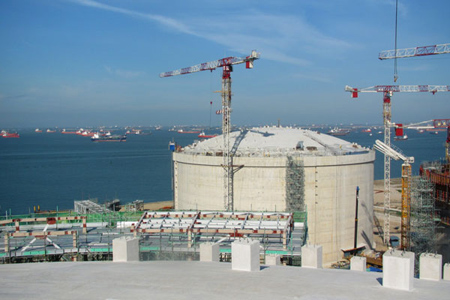
(Photo credit: Singapore LNG Corporation)
Next year, Singapore, the world's busiest port, will open its first liquefied natural gas (LNG) terminal, slated to become one of the largest in Asia by 2020. Its creation is based on the belief that Asia is on the cusp of entering "a golden age of gas" as a commercial and clean energy source.
Located on Jurong Island and built at a cost of S$1.7 billion, the terminal will help Singapore diversify its gas supplies, and achieve other economic and environmental benefits.
It can import and store super-chilled gas from different producers and deliver regasified LNG to local end-users, ensuring that the country is less susceptible to price and supply risks
It will also be the first LNG terminal in Asia that can accommodate multiple types of ships, with the capability to re-export LNG cargoes. Almost all of the 100 terminals in service worldwide--with around 40 or so of them located in Asia--are used exclusively to export or import LNG.
A catalyst for new opportunities
The Singapore terminal's efficient design allows it to unlock potential new business opportunities.
There is free land within the terminal site--so that Singapore LNG Corporation, the terminal's owner, can further increase its production capacity and services while keeping the facility's footprint to a minimum.
Producing around 6 million tonnes per annum (Mtpa) of LNG, with the potential to increase this to 12Mtpa within the next decade, the terminal will initially cater to domestic needs.
Its capability for expansion, however, will spur the development of LNG trading activities in Asia, complementing an already vibrant oil trading community for which Singapore has become well-known.
In the last few years, several LNG trading houses have already established a strong presence here, in line with the view that Singapore can be a hub for short-term sales trading of LNG. This has given rise to an industry in tailored risk-management products and services centring on LNG.
By dint of geography, Singapore is a natural centre of gravity between the gas fields of Australia, the Americas and Africa, and end-users in Asia. As LNG flows to Asia increase, there are expectations that buyers will seek more flexible contract price structures.
The current business model of long-term take or pay contracts with limited flexibility is likely to evolve into shorter-term deals that fit with sudden changes in demand and prices.
This will drive the growth of an LNG spot trading market, simultaneously providing Singapore the opportunity to grow its talent base--and skill sets of employees--in this specialist area.
An added dimension to existing infrastructure
The eventual goal is for the terminal to become a regional LNG trans-shipment hub, similar to the roles that the Port of Singapore Authority and Changi Airport now play when it comes to container shipments and aviation.
As gas becomes a crucial feedstock to underpin Asia's economic expansion, the terminal can be a fully-functioning gateway to break down bulk LNG supplies and redistribute them to regional destinations that either cannot afford to build large LNG terminals or have port facilities too small to handle the giant LNG tankers.
It could also potentially offer LNG bunkering services to ships that would use hybrid LNG and oil-based fuel systems in the future, adding another dimension to Singapore's port role.
Facilitating trade and cutting emissions
Natural gas is currently piped into Singapore from Malaysia and Indonesia, making up 80 percent of the island-state's electricity generation mix. This is expected to rise to 90 percent by 2030, as Singapore continues to work towards reducing carbon emissions.
In the region, natural gas usage has already increased three-fold since 1990 and LNG consumption volumes in Asia are predicted to double in the next 15 years.
It will not be plain sailing for LNG, however, as it still competes with coal and cheaper natural gas delivered by pipelines. But regional governments are increasingly cognisant of the benefits of gas as a clean-burning fuel, with generally lower costs per calorie than oil.
Japan, Korea and Taiwan are currently the biggest LNG importers, while in Southeast Asia, Singapore, Malaysia, Indonesia, Thailand, Vietnam and the Philippines are expected to become LNG importers in the next few years as China and India expand their LNG consumption.
LNG supply now comes from several ASEAN countries, Australia, and the Arabian Gulf, with new reserves being developed in China, India and further afield in East Africa. The discovery of shale gas in the US has also turned it into a potential LNG source.
These developments strongly indicate that LNG importation and trade are multi-billion-dollar opportunities for Singapore, adding to the already-significant investments in its thriving oil and petrochemical sectors.
Singapore's LNG terminal is opening for business at a time when it can be a key player in Asia's increasing significance in the global LNG trade.

Neil McGregor is Chief Executive Officer of the Singapore LNG Corporation. He has over three decades of experience in the oil, gas and power generation sectors.
By: Neil McGregor, SLNG Corp